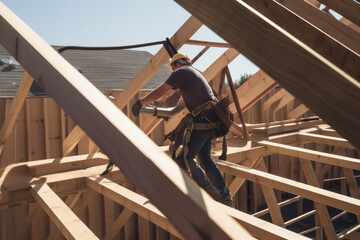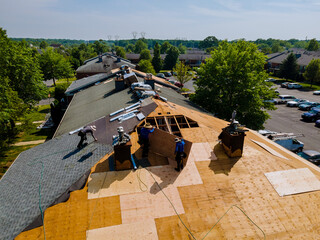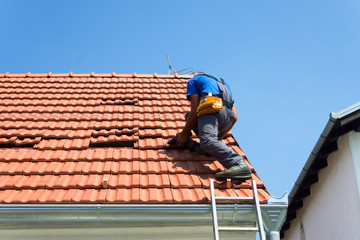Residential Roofing is the umbrella term for roof services that pertain to structures designed for people to live in, particularly houses. It’s important to understand the differences between the various types of roofing. There are four main roofing materials to choose from for your home.

Asphalt shingles are today’s most popular roofing material for residential homes. They’re less expensive than other roof types, such as clay tiles, wood shakes or metal, and come in many colors and styles that work with most home designs. This type of roofing also adds value to the home and offers great protection from outdoor elements.
The protective nature of shingles primarily comes from long-chain hydrocarbons that are impregnated in the paper. These hydrocarbons soften when exposed to sunlight and rain, then are washed off the shingle. This prevents the shingle from deteriorating and losing its structural integrity. Along eaves and complex rooflines the loss of these hydrocarbons occurs faster because water is channeled through the shingle.
In addition, the granules (small pebble-like particles) on an asphalt shingle are treated to resist different environmental factors. These treatments can include an algae-resistant granule that protects the shingle from discoloration caused by blue-green algae, as well as cool roof color granules that reflect more of the sun’s energy, keeping homes cooler and reducing air conditioning costs.
Many manufacturers offer specialized shingle styles to meet specific design and function needs. For example, some shingles are rated as impact resistant which can help reduce homeowner’s insurance premiums in areas that experience frequent hailstorms. Others feature a high fire rating that can contribute to a building’s NFPA rating and can protect the structure from ember penetration and spread of fire in a chimney flue.
Another shingle option is a multi-layered laminated shingle designed to create a rich, dimensional appearance. These shingles are thicker and more durable than three-tab shingles and can even mimic the look of wood shakes or natural slate roofing aesthetics. They’re often referred to as “luxury” or “designer” shingles and may have a higher up-front cost than traditional shingle styles, but can save homeowners money in the long run through their durability and energy savings.
All shingles are tested to ensure they can hold up to various wind speeds, and most come with a Lifetime Limited Warranty from the manufacturer. IKO shingles are engineered to withstand 110-130 mph winds and have a Class H UL (Underwriter’s Laboratory) rating, which means they can provide outstanding weather resistance.
Metal
Metal roofing is gaining popularity among residential roofs, due to its durability and long lifespan. This type of roofing is available in many colors and styles to suit a variety of architectural designs. It is also resistant to snow, hail, and high winds. It is easy to install and can be more affordable than other types of roofing materials. However, it is important to consult a professional before choosing the right type of roofing for your home.
A far cry from the corrugated tin barns of the past, today’s metal shingles are available in a wide variety of color options. They can be made of galvanized, aluminum, or copper, and are often coated with protective layers to prevent rusting. They are also lightweight, which makes them easier to install than other roofing materials that require a reinforced structure underneath them. They also reflect the sun’s heat, which can help to reduce energy bills.
The two main types of metal roofing are standing seam and stamped or “stripped” sheet systems. Stamped metal roofing is a popular choice in the residential market, as it looks like asphalt shingles and offers many of the same warranty options. In contrast, standing seam metal is typically used for commercial roofs and can be incorporated into architectural designs. Both of these roofs can be painted to match any exterior color scheme, and both are a great choice for homeowners that want to boost their property’s curb appeal.
Another great option for environmentally-conscious homeowners is to choose a green roofing material. This type of roofing is a green alternative to traditional roofing materials, as it uses vegetation that is beneficial to local wildlife and helps to reduce air pollution. It is also fire-resistant, which can save your client money on their insurance premiums. In addition, it can increase the resale value of their home and can even lower their utility bills. However, it is important to check with your client’s homeowners association before making this type of roofing choice, as some associations may not allow the use of certain roofing materials.
Synthetic Shingles
The roofing industry is abuzz with a new type of roof called a “synthetic” or “polymer composite shingle.” These advanced shingles have more to offer than traditional asphalt shingles, which are well-known for their brittleness and loss of granules. As a residential roofing contractor in Hampstead, Maryland, we’re frequently asked about these alternative shingles. Let’s take a look at what makes them so appealing to homeowners.
They’re low-maintenance. The best quality synthetic slates need very little maintenance, other than perhaps a yearly check to make sure there are no missing shingles or that none have come loose or shifted. These shingles don’t attract moss or lichens, and they don’t have any organic materials to absorb moisture and lead to leaks and mold issues. Because they’re inorganic, they also don’t absorb and lose granules like asphalt shingles do. In addition, they don’t have the same problem of clogging gutters that can happen with wood shingles, especially when squirrels deposit their acorns and pinecones on the roof.
Synthetic slate shingles are also very durable and resistant to damage from wind, hail, snow, or even walking on the roof. They’re usually certified by Underwriters Laboratories for Class 4 impact resistance, which is higher than the standard for many types of shingles. Additionally, they are fire-resistant. This may not sound like a big deal until you realize that on average, a house fire occurs every 89 seconds and that one of the biggest causes is roofs that are burning up.
Because they are made from recycled materials, synthetic shingles are a sustainable roofing option that doesn’t require the use of fossil fuels and mined minerals in their production. They’re recyclable, and they have a 30 to 50 year lifespan—which is much longer than that of asphalt shingles or cedar shakes.
Another reason to consider synthetic shingles is that they can be manufactured to look just like traditional slate and wood shingle roofs. They can even be molded to have chisel marks or deeper grain patterns, making them difficult for non-roofers to tell apart from the original material at curbside distance. This makes them a good choice for homeowners who are concerned about environmental responsibility and want the look of authentic slate or wood shakes on their home’s roof at a lower cost than the original materials would have.
Tiles
Tile roofs add a touch of class and beauty to your home. They offer a wide variety of design options, including earth-colored clay, slate and concrete tiles. Some styles resemble traditional shingles or wood shakes for a rustic aesthetic. They are also fireproof and long-lasting, able to withstand wind up to 150 mph. They can be more expensive than shingle roofs, however, and require structural reinforcement to support their weight.
You’ll often see tile roofs in areas that experience extreme weather conditions, like the Southwest and coastal Florida. This is because they can resist hot temperatures and salt air, and they’re also excellent at shedding rainwater from cloudbursts. However, these roofs may not perform as well in cold climates, so you should consider other roofing materials if you live in an area with freezing temperatures.
In addition to adding visual appeal, a tile roof is also an excellent energy-efficient choice. It insulates your house better than shingle roofs, so you can save money on heating and cooling costs. Additionally, tile roofs reflect solar energy rather than absorbing it, which makes them more effective in warmer climates.
Unlike asphalt shingles, which are made of organic material, tile is comprised of mineral materials, so it is environmentally friendly and durable. Its heavy thermal mass helps regulate indoor temperature, and it’s recyclable when it’s replaced. Tile roofs also last longer than shingle roofs, and many manufacturers offer up to 100-year warranties.
The offers that appear on this page are from companies from which The Spruce receives compensation. This helps fund our journalism. Find out more here.
A tile roof can be a good investment, but it’s important to understand the unique construction and maintenance requirements of this type of roofing. As a general rule, it’s best to leave the inspection of a tile roof to professional roofing contractors who specialize in this particular roofing material. The inspector should be able to identify any issues with the structure, ventilation, leaks and other factors that could affect a tile roof’s performance. This knowledge will give your clients peace of mind that they’re getting a top-quality roof that will protect their property for decades to come.


